May 25-28
This year an old friend of mine and I had planned a spring cruise for the last week-end of May. Due to a holiday on thursday we would take a long week-end and sail thursday to sunday, four days.
My friend arrived at the airport on wednesday evening and after having
bought some last supplies and eaten some food at a restaurant nearby we
drove to the club and settled on the boat. After a late night coffe we
went to bed. The day had been very windy with wind speeds of half a
gale, but the forecast ensured os the wind would drop during the night.
The next day it was to pick up again, but not as much and still be from
the right direction to enable us to a good reach out into the
archipelago.
The night was a bit disturbed by a big bang at about 0100 which origin
we were not able to find out. The next morning, though, I listened to
the radio for a weather forecast and caught the news talking about that
noise and stating that nobody knew what it had been. Apparently people
had called the police and they even had despatched a helicopter to look
for signs of an explosion, but to no avail.
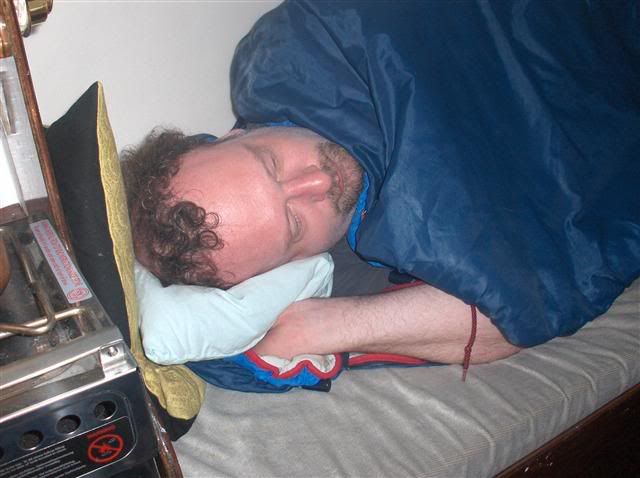
Anyway, the next morning we set sail at 0940. The winds were then
light, despite the forecast. Also we had to tack all the way out of the
long inlet instead of reaching. After a few hours we changed the
foresail to the big genoa, but that did not help as the wind dropped to
nothing a short while afterwards. We waited some, but then decided to
use the engine for the last mile to our destination, the little island
of Getfoten. Getfoten is owned by a sailing club and has even a
restaurant. When we neared the place we saw a lot of sails and I got a
trifle worried that there would be a regatta and the harbour full of
boats. I called my wife on the mobile and asked her to find out by
means of the internet if there would be any sign of a regatta. When she
got back to me, having found nothing, the sails had dispersed.
Soon afterwards we reached the island. At the same time it started to
rain furoiusly so we had to conduct our mooring maneuvre in pouring
rain. That completed we went directly to the restaurant to warm up,
have a beer, some food and a few cups of hot coffee. There were about
seven boats in the harbour, but we were informed that only the day
before there were over a hundred. So there was a regatta, but they had
departed not to come back. Luck for us. We had a comfortable night,
although it started to blow quite a bit, with halyards and shrouds
rattling on the boats.
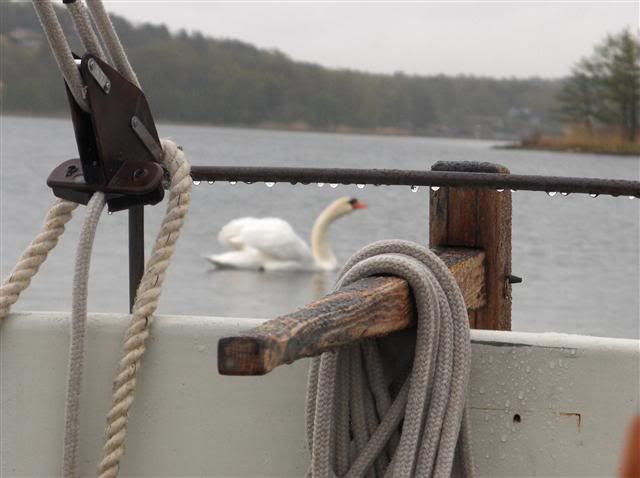
The next morning it was raining and did so until lunch. We had a long
cosy breakfast with scrambled eggs (with onions), tea, coffee and
orange juice. The stove had to work hard not only to warm the food but
to keep the cabin warm. The dock at Getfoten shortly before we left:
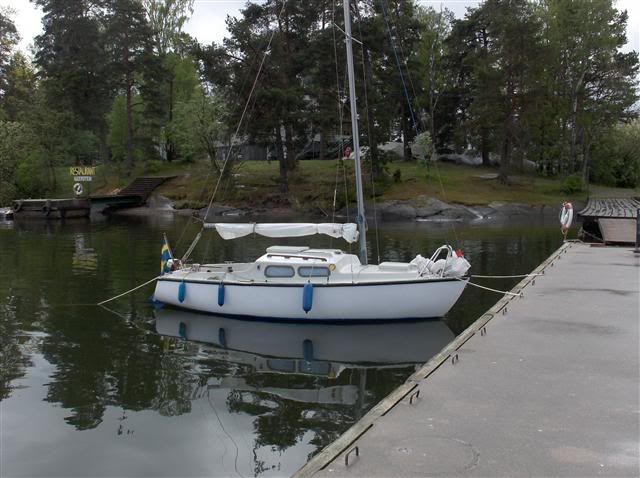
At around midday the rain stopped and the sun did in fact peak out.
However, we saw a new dark front of clouds approaching from the west.
We had two alternative options at that time, one was to sail to the
nearby town of Vaxholm to the north or to a cove to the south. I was a
bit in favour of the cove, but my friend who was keen on seeing the
famous castle at Vaxholm, the fact that there were warm pubs there and
the dark front approaching, made me decide to go for Vaxholm.
We sailed there in about two hours in mostly light winds, still with
minimal use of the engine. We even left the harbour at Getfoten under
sail. It was quite sunny during our passage, but shortly after we
arrived it started to rain. And so it continued in hourly intervals.
One hour of rain. One hour of sun. And so on. This destroyed all plans
of leaving again, so we settled for the night after a stroll in the
town and a visit to a café. At that cafè I also found a
newspaper reporting that the "bang" we had heard two days before
actually had been an earthquake. Now earthquakes are extremely rare in
Sweden and this one, being a 2 on the Richter scale did not harm
anybody, but quite a fews buildings did shake. Being on a boat, we of
course did not feel anything of this.
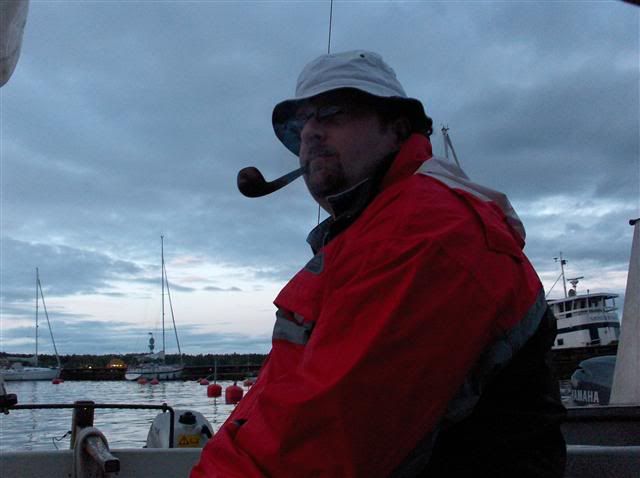
We left Vaxholm early the third day. Now the forecast was of moderate
winds, decreasing to almost nothing in the afternoon. So we started
early to catch the wind that was and get to a small harbour halfway
between Vaxholm and home as my friend wanted to be in Stockholm sunday
afternoon at the latest. Of course the forecast was wrong again. There
was some wind all right, but instead of decreasing it increased
continuously until lunchtime. We started with full sails, changed from
genoa to jib after a third of the distance and took a reef in the main
after another third. And of course all the time we had to beat.
Anyway, we reached our destination after a really good sail, although a
bit cold at around 1300. We had a good lunch and settled for a quiet
evening at that place. Or so we thought. Soon it dawned on us that
there was some activity at the club house directly in front of the
dock. Enquiries showed that there was a party to be that evening for
someone's 50th birthday. So we had a problem.

It was apparent that we would not be able to sleep until very late if
we stayed. Also the forecast for next day was of very light winds and I
did not feel for motoring all the way home. Instead we decided to set
sail again directly. We left at 1600 and were in fact able to sail half
the distance home, athough very slowly for the last part. At 1900 the
wind died totally and we started the engine that brought us home on a
mirrorlike sea and under a still quite high northern sun one hour
later.
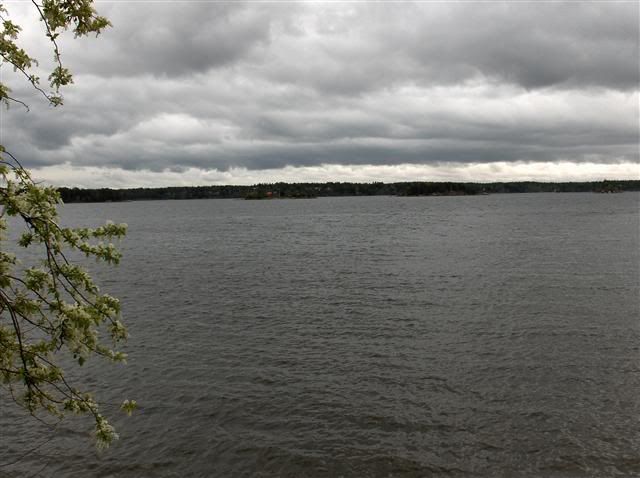
Although thus being somewhat curtailed the cruise was a success. It
showed that there can be done some very nice sailing even in adverse
cold and rainy conditions like those. Still I have never before slept
in a sleeping bag with clothes on and an extra blanket inside the
packet to keep warm. Temperatures were never over 15C, mostly around 10
and surely lower during the nights. Also there was quite some rain and
the wind was very cold. Still we kept the spririts up, drank some
rum-and-hot-water-grogs and had a good time as only old friends can.
 This is my dad, trying his first turn at the tiller. He really is not
this fat, but wears a life vest under his raingear! Still he does look
a bit like a polar explorer, which he he in fact may have felt like.
We had left the club harbour at 1145 and our destination was Getfoten,
an island which has a nice marina, and, most importantly in this
weather, a pub. The winds were light in the beginning, but came from
the north, meaning that after some initial tacking to get out into more
open water, we creamed along nicely on a beam reach.
Still, at 1400 the wind dropped considerably and fog started to drift
in. This was not good as it meant we would not get to Getfoten and the
pub. We might have been able to carry on and find it in the fog (the
visibility was still about one nautical mile), but we did not have
enough wind to get there quickly enough as we now had started to feel a
bit cold. Also we would have to cross a shipping lane, which is never a
good thing to do in the fog. And if we had done it using the engine we
would not have heared other vessels as the Honda is quite loud.
This is my dad, trying his first turn at the tiller. He really is not
this fat, but wears a life vest under his raingear! Still he does look
a bit like a polar explorer, which he he in fact may have felt like.
We had left the club harbour at 1145 and our destination was Getfoten,
an island which has a nice marina, and, most importantly in this
weather, a pub. The winds were light in the beginning, but came from
the north, meaning that after some initial tacking to get out into more
open water, we creamed along nicely on a beam reach.
Still, at 1400 the wind dropped considerably and fog started to drift
in. This was not good as it meant we would not get to Getfoten and the
pub. We might have been able to carry on and find it in the fog (the
visibility was still about one nautical mile), but we did not have
enough wind to get there quickly enough as we now had started to feel a
bit cold. Also we would have to cross a shipping lane, which is never a
good thing to do in the fog. And if we had done it using the engine we
would not have heared other vessels as the Honda is quite loud.
 So we decided to go into the small marina at Bosön which was close
nearby. This was the right decision as the fog got a lot denser later.
So we decided to go into the small marina at Bosön which was close
nearby. This was the right decision as the fog got a lot denser later.
 We had a late luch and settled to read our books. My dad has just
published his first detective novel and I was eager to read it, while I
had put him to read "The Riddle of the Sands" in order to get him in a
nautical mood. During the evening the fog lifted and suddely there
apperad a crowd of children in small dinghies, so we had some action to
watch for dinner. The night was quite cold and we had to sleep in our
sleeping bags with the clothes on.
The next morning the wind was light, still from the north and we
decided to quit on the pub and instead beat our way to an anchorage
from where we easily could reach the home port later, whatever the wind
decided to do. We put up the genoa instead of the jib and after a while
the wind picked up enough for 4 or 5 knots of speed. Just before we
reached the anchorage the sun actullay showed herself between the
clouds.
We had a late luch and settled to read our books. My dad has just
published his first detective novel and I was eager to read it, while I
had put him to read "The Riddle of the Sands" in order to get him in a
nautical mood. During the evening the fog lifted and suddely there
apperad a crowd of children in small dinghies, so we had some action to
watch for dinner. The night was quite cold and we had to sleep in our
sleeping bags with the clothes on.
The next morning the wind was light, still from the north and we
decided to quit on the pub and instead beat our way to an anchorage
from where we easily could reach the home port later, whatever the wind
decided to do. We put up the genoa instead of the jib and after a while
the wind picked up enough for 4 or 5 knots of speed. Just before we
reached the anchorage the sun actullay showed herself between the
clouds.
 And the polar explorer got his sunglasses out! Soon we reached the
anchorage and made fast to some small trees and the stern anchor,
Swedish fashion.
And the polar explorer got his sunglasses out! Soon we reached the
anchorage and made fast to some small trees and the stern anchor,
Swedish fashion.
 Don't say anything about the fenders, my wife has already mocked me
about that. And they do have to be somewhere, even if we never saw
another boat while in that anchorage. My dad started to explore the
rocks and trees and soon became involved with a female duck as well.
Don't say anything about the fenders, my wife has already mocked me
about that. And they do have to be somewhere, even if we never saw
another boat while in that anchorage. My dad started to explore the
rocks and trees and soon became involved with a female duck as well.
 She got a bit disappointed though when she heard he was already
married. Below she is seen on her way back to the water....
She got a bit disappointed though when she heard he was already
married. Below she is seen on her way back to the water....
 Thanks to the sun it was quite warm now and we could drink our tea
sitting in the cockpit with the table out. However, at dinner time the
sun was gone, the clouds where back and we dined below again. Still the
night was not as cold as the first one, despite some rain in the late
evening hours.
The anchorage is in a small inlet called Kyrkfjärden. To get there
you have to sail through a sound that is only 4 meters wide and about
1,5 m deep. So this is really a place for small boats, and even if
there use to be quite a few motorboats during summer, this time we were
totally alone. However, the sound has not always been this small. I
have been told that 20 years ago tourists could go by steam launch from
Stockholm to the small castle north of the inlet.
Thanks to the sun it was quite warm now and we could drink our tea
sitting in the cockpit with the table out. However, at dinner time the
sun was gone, the clouds where back and we dined below again. Still the
night was not as cold as the first one, despite some rain in the late
evening hours.
The anchorage is in a small inlet called Kyrkfjärden. To get there
you have to sail through a sound that is only 4 meters wide and about
1,5 m deep. So this is really a place for small boats, and even if
there use to be quite a few motorboats during summer, this time we were
totally alone. However, the sound has not always been this small. I
have been told that 20 years ago tourists could go by steam launch from
Stockholm to the small castle north of the inlet.
 The last morning started with the usual cloudy weather and light winds
that fortunately stayed in the north so we made it home in a
gentlemanly manner (not having to tack) and in good time before the fog
again drifted in (and the birthday dinner started).
This was not a long cruise, especially not in hours or miles sailed,
but it was a nice one, despite the crap weather. At least we had the
water almost for ourselves.
Finally,here is a small movie clip proving that Daddy finally learned to sail.
The last morning started with the usual cloudy weather and light winds
that fortunately stayed in the north so we made it home in a
gentlemanly manner (not having to tack) and in good time before the fog
again drifted in (and the birthday dinner started).
This was not a long cruise, especially not in hours or miles sailed,
but it was a nice one, despite the crap weather. At least we had the
water almost for ourselves.
Finally,here is a small movie clip proving that Daddy finally learned to sail.


























































